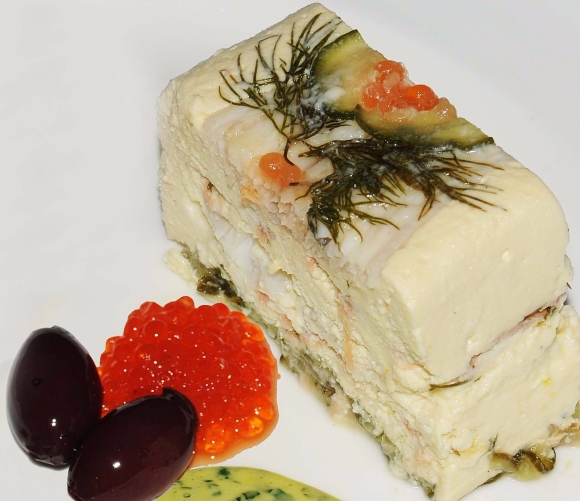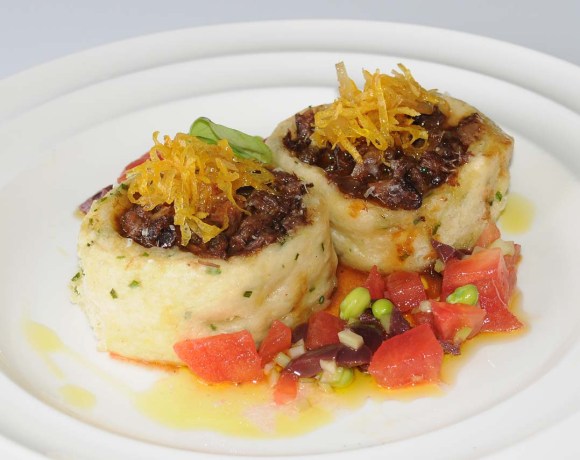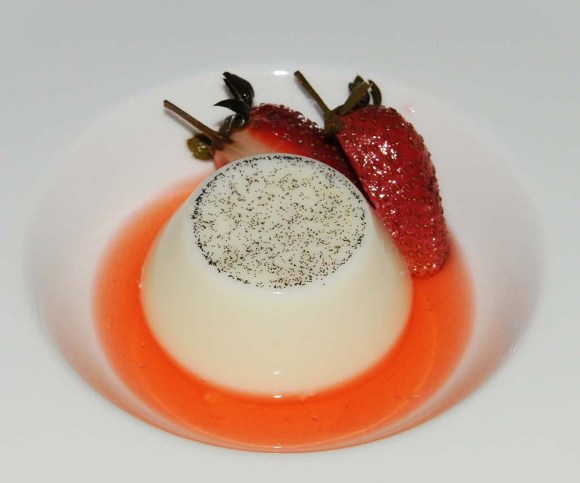Serve with Puy lentils, candied sweet potatoes and tomato and basil terrine.

Serves 4
Brisket is an inexpensive cut of beef that requires long, slow cooking to break down the collagen in the connective muscle tissues which results in succulence and tenderness. The Tomato and basil terrine is a refreshing addition to the rich brisket dish.

The brisket:
2 tablespoons/30 ml olive oil
1 kg/2 lbs brisket with the bone on
3 cloves garlic, crushed
1 red onion, roughly chopped
1 cup/250 ml dry red wine
2 cups spicy beef stock, heated
1 teaspoon/5 ml fresh ginger, grated
juice of ½ lemon
2 teaspoons/10 ml palm sugar
1 star anise
salt and freshly ground pepper
1 red chili, rib and seeds removed, finely chopped (optional)
The Puy lentils:
200 g/7 oz Puy lentils
1½ cup chicken stock
salt and freshly ground black pepper
1 medium red onion, finely sliced
1 tablespoon/15 ml lemon juice
1 tablespoon/15 ml olive oil
salt and freshly ground black pepper
The sweet potatoes:
4 large sweet potatoes, peeled and cut across into 1 cm (0.4 in) thick slices
¼ cup/60 ml butter
¼ cup/60 ml sugar
juice of one orange
The tomato and basil terrine: (Optional)
1 cup/250 ml olive oil
½ cup/125 ml balsamic vinegar
4 shallots, peeled and finely sliced
4 garlic cloves, minced
salt and freshly ground black pepper
1.5 kg (3.3 lbs) very ripe tomatoes, peeled, sliced into petals and seeded
1 bunch basil
baby rocket leaves
Start with the terrine: (If making)
For the marinade, combine the olive oil, vinegar, shallots, garlic and seasoning. Add the tomatoes to the marinade and refrigerate for 24 hours.
For the terrine, line four individual molds with plastic film, then push in each mold a layer of the tomato petals, then a basil leave, then salt and pepper and a drizzle of the marinade. Repeat until all the ingredients are used and pour the rest of the marinade over. Press down firmly and fit a piece of board cut to the size of the mold on top. Put small weights on top and leave for at least 8 hours to set before serving.
When ready to serve, invert the terrines on each of the serving plates with the brisket, Puy lentils and sweet potatoes.
For the brisket, heat the oil in a large saucepan and brown the brisket all over. Add the garlic and onion and stir until heated through, then add the red wine and allow to boil until almost evaporated. Add the beef stock and bring to a boil, then add the rest of the ingredients and cook, covered, for about ½ hour. Remove the star anise and continue cooking for another hour or until the meat is very tender. Check periodically to see that there is enough liquid to cover the meat. If necessary add a little bit of boiling water from time to time.
When the brisket is tender, remove from the saucepan and keep in a warm place. Add the chili (optional) to the saucepan and reduce the liquid in the pan until it is thick and syrupy.
Shred the brisket into smaller pieces, discard the bones (if any) and return the meat to the saucepan. Gently mix with the sauce in the pan and check the seasoning. Keep warm.
Cook the lentils in simmering unsalted chicken stock for 20 minutes or until tender. Drain and season with salt and freshly ground black pepper.
Meanwhile, soak the red onion in the lemon juice for 5 minutes. Once the lentils are cooked, add the drained onion, olive oil and stir through.
In a saucepan, put the sweet potatoes and cover with water, salt and half the butter. Bring to the boil and cook until nearly all the water has evaporated. Pour in the orange juice, the rest of the butter and the sugar. Turn the heat down low and let the juices slowly caramelize.
Assemble the dish:
Serve the brisket on top of the Puy lentils with the Sweet potatoes and the Tomato and basil terrine (if using) around it.









